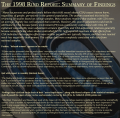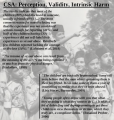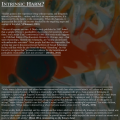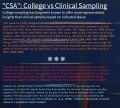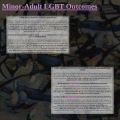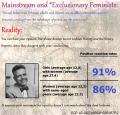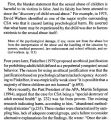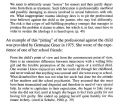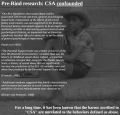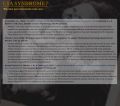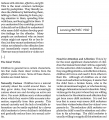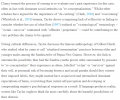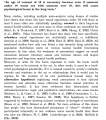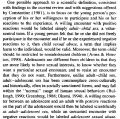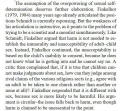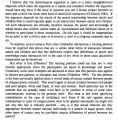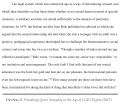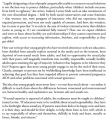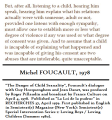One of our staff members is contributing considerably to a News Archiving service at Mu. Any well educated (Masters, PhD or above) users who wish to make comments on news sites, please contact Jim Burton directly rather than using this list, and we can work on maximising view count.
Research: Prevalence of Harm and Negative Outcomes
 | ||||||||||||
| Part of NewgonWiki's research project | ||||||||||||
|---|---|---|---|---|---|---|---|---|---|---|---|---|
|
| ||||||||||||
| ||||||||||||
|
| ||||||||||||
| Template: Research - This template |
Research (much of it outdated) investigating CSA as a clinical/legal/traumatic phenomenon, using similarly obtained samples is wrongly generalized by practitioners and educators to the entire population. Society is not an enormous clinic, so why should we assume these studies are representative?
This article pools mainly nonclinical, nonlegal and nontraumatic sampled research articles documenting the prevalence of harm. Rind et al (1998) confirmed that CSA is not a reliable predictor of later maladjustment, when other factors are accounted for. Self-perception of (simple) consent is also a strong predictor of indifferent or positive outcomes. These results have been re-affirmed as recently as 2021 by Daly. On the other hand, non-consent is even correlated with negative outcomes for adult men victimized by women.[1]
As a side note, prevalence of CSA is widely held to be "1 in 10" for the purpose of clarity in victim advocacy, but varies by gender and depending on definition of abuse (peer vs adults only, etc). None of these are settled debates.[2]
Outcomes
- Rind, Bruce; Tromovitch, Philip; Bauserman, Robert (1998). "A Meta-Analytic Examination of Assumed Properties of Child Sexual Abuse Using College Samples", Psychological Bulletin, 124(1), 22-53, doi:10.1037/0033-2909.124.1.22
- Note: Successfully replicated by Ulrich[3] and Daly below.
- "Many lay persons and professionals believe that child sexual abuse (CSA) causes intense harm, regardless of gender, pervasively in the general population. The authors examined this belief by reviewing 59 studies based on college samples. Meta-analyses revealed that students with CSA were, on average, slightly less well adjusted than controls. However, this poorer adjustment could not be attributed to CSA because family environment (FE) was consistently confounded with CSA, FE explained considerably more adjustment variance than CSA, and CSA-adjustment relations generally became nonsignificant when studies controlled for FE. Self-reported reactions to and effects from CSA indicated that negative effects were neither pervasive nor typically intense, and that men reacted much less negatively than women. The college data were completely consistent with data from national samples. [...]
- Fifteen studies presented data on participants' retrospectively recalled immediate reactions to their CSA experiences that were classifiable as positive, neutral, or negative. Overall, 72% of female experiences, but only 33% of male experiences, were reported to have been negative at the time. On the other hand, 37% of male experiences, but only 11% of female experiences, were reported as positive. [...] Seven female and three male samples contained reports of positive, neutral, and negative current reflections (i.e., current feelings) about CSA experiences. Results were similar to retrospectively recalled immediate reactions, with 59% of 514 female experiences being reported as negative compared with 26% of 118 male experiences. Conversely, 42% of current reflections of male experiences, but only 16% of female experiences, were reported as positive. [...] The overall picture that emerges from these self-reports is that (a) the vast majority of both men and women reported no negative sexual effects from their CSA experiences; (b) lasting general negative effects were uncommon for men and somewhat more common for women, although still comprising only a minority; and (c) temporary negative effects were more common, reported by a minority of men and a minority to a majority of women."
- Daly, N. R. (2021). Relationship of Child Sexual Abuse Survivor Self-Perception of Consent to Current Functioning, PhD thesis.
- "In 1998 Rind, Tromovitch and Bauserman conducted a meta-analysis using a college sample which challenged the prevailing belief that childhood sexual abuse (CSA) has inherent deleterious effects. Resultantly, the authors proposed alternative terminology (e.g., child-adult sex), without adequate investigation into what distinguishes child-adult sex from CSA. In response, the current study investigated the relationship between CSA, consent and adult functioning in a college sample [...] These results suggest that based on CSA status, a college sample does not exhibit significant deficits in psychological functioning or family environment and may not be comparable to samples of CSA survivors in the general population."
- Lahtinen, H., et al., (2018). "Children's disclosures of sexual abuse in a population-based sample," Child abuse and Neglect, Feb 2018; 76: 84-94.
- Note: 2.4% of the sample (12 and 15 year olds) reported CSA experiences, of which the majority found them to be positive. For the boys, the experience was often positive (71%) vs (9% negative), whereas for the girls it was less often so evaluated (26%) vs (46%) negative. The most popular reason for not disclosing the contact to an adult was considering the experience not serious enough (41%). Despite a CSA sample of 256, the authors bizarrely refused to test for statistical significance of trends.
- "The small number of answers to the question of whether a sexual incident with an adult was considered negative or positive does not enable testing statistical significance [...] Most of the children reported these incidents as positive. This highlights the potentially contradictory views of an incident from the perspective of the respondent compared to that of society and the law [...] These results, taken together with the finding that many of the children did not label their experiences as sexual abuse, indicate that more age-appropriate safety education for children and adolescents is needed to encourage disclosures to adults early enough [...] Early disclosure is crucial, both for ending the abuse and for preventing perpetrators from moving on to new victims."
- Rind, B. (2020). "First Sexual Intercourse in the Irish Study of Sexual Health and Relationships: Current Functioning in Relation to Age at Time of Experience and Partner Age," Archives of Sexual Behavior, 50(1):289-310.
- "The vast majority of cases involved postpubertal heterosexual coitus. Overall, minors involved with adults were not significantly less well adjusted than adults involved with other adults on a majority of measures, effect size differences in adjustment were mostly small, and mean adjustment responses consistently indicated good rather than poor adjustment."
- Rind, B. (2022). "Reactions to Minor-Older and Minor-Peer Sex as a Function of Personal and Situational Variables in a Finnish Nationally Representative Student Sample", Archives of Sexual Behavior, 51, p. 961–985.
- "Felson et al. (2019) used a large-scale nationally representative Finnish sample of sixth and ninth graders to estimate the population prevalence of negative subjective reactions to sexual experiences between minors under age 18 and persons at least 5 years older and between minors and peer-aged partners for comparison. They then accounted for these reactions in multivariate analysis based on contextual factors. The present study argued that focusing exclusively on negative reactions short-changed a fuller scientific understanding. It analyzed the full range of reactions in the same sample, focusing on positive reactions. For reactions in retrospect, boys frequently reacted positively to minor-older sex (68%, n = 280 cases), on par with positive reactions to boy-peer sex (67%, n = 1510). Girls reacted positively to minor-older sex less often (36%, n = 1047) and to girl-peer sex half the time (48%, n = 1931). In both minor-older and minor-peer sex, rates of positive reactions were higher for boys vs. girls, adolescents vs. children, when partners were friends vs. strangers or relatives, with intercourse vs. lesser forms of sexual intimacy, with more frequent sex, and when not coerced. Boys reacted positively more often with female than male partners. In minor-older sex, partner age difference mattered for girls but not boys, and the minor’s initiating the sex (14% for girls, 46% for boys) produced equally high rates of positive reactions. Most of these factors remained significant in multivariate analysis. The frequency of positive reactions, their responsiveness to context, the similarity in reaction patterns with minor-peer sex, and the generalizability of the sample were argued to contradict the trauma view often applied to minor-older sex, holding it to be intrinsically aversive irrespective of context."
- Note: Rind's analysis also identified that boys initiated 46% of their encounters with significantly older people (recalling 82% of such experiences positively), and likewise 14% for girls (79% positive recall). For girls, rates of positive reactions increased from noncontact sex to sexual touching to sexual intercourse in both minor-peer and minor-older sex, with similar rates at each level of intimacy. For intercourse, most girls reacted positively, whether with peers (57%) or older partners (63%). On the other hand, for non-contact sex, few reacted positively, whether with peers (14%) or older partners (8%). Era-related degradation in quality of experience was also indicated, suggesting moral values were to blame for some negative subjective recall. Girls with older partners reacted more negatively (46% vs. 31%) and less positively (26% vs. 47%) in the 2008–2013 surveys than in the 1988 survey. For boys, however, no signifcant diferences occurred.
- For a fuller analysis of this paper and its findings see our primer.
- Rind, B. (2023). Subjective Reactions to First Coitus in Relation to Participant Sex, Partner Age, and Context in a German Nationally Representative Sample of Adolescents and Young Adults. Arch Sex Behav. Jul;52(5):2229-2247. doi: 10.1007/s10508-023-02631-5. Epub 2023 Jun 7. PMID: 37286764.
- "Analysis of a Finnish nationally representative student sample found that subjective reactions to first intercourse (mostly heterosexual; usually in adolescence) were highly positive for boys and mostly positive for girls, whether involved with peers or adults (Rind, 2022). The present study examined the generality of these findings by examining subjective reactions to first coitus (heterosexual intercourse) in a German nationally representative sample of young people (data collected in 2014). Most first coitus was postpubertal. Males reacted mostly positively and uncommonly negatively in similar fashion in all age pairings: boy-girl (71% positive, 13% negative); boy-woman (73% positive; 17% negative); man-woman (73% positive, 15% negative). Females' reactions were more mixed, similar in the girl-boy (48% positive; 37% negative) and woman-man (46% positive, 36% negative) groups, but less favorable in the girl-man group (32% positive, 47% negative). In logistic regressions, adjusting for other factors, rates of positive reactions were unrelated to age groups. These rates did increase, in order of importance, when participants were male, their partners were close, they expected the coitus to happen, and they affirmatively wanted it. Reaction rates were computed from the Finnish sample, restricting cases to first coitus occurring in the 2000s, and then compared to minors' reactions in the German sample. The Finns reacted more favorably, similarly in both minor-peer and minor-adult coitus, with twice the odds of reacting positively. It was argued that this discrepancy was due to cultural differences (e.g., Finnish culture is more sex-positive)."
- Larsen, K. & Larsen, H. (2007). "The prevalence of unwanted and unlawful sexual experiences reported by Danish adolescents: Results from a national youth survey in 2002," Acta Paediatrica, 2006 Oct;95(10):1270-6.
- Note: The youth were all aged 15. Specific data in tables revealed that 7.5% of girls and 2% of boys reported encounters with a 5+ year age gap or more - 59 and 65% respectively felt they had not been abused.
- "Multimedia computer-based self-administered questionnaires (CASI) were completed by a national representative sample of 15–16-y-olds. Child sexual abuse was defined according to the penal code and measured by questions defining specific sexual activities, the relationship between the older person and the child, and the youth's own perception of the incident. Results: Among 5829 respondents, 11% reported unlawful sexual experiences, 7% of boys and 16% of girls. Only 1% of boys and 4% of girls felt that they “definitely” or “maybe” had been sexually abused. Conclusion: A relatively high percentage of Danish adolescents have early, unlawful sexual experiences. However, young people's own perception of sexual abuse tends to differ from that of the authorities, or their tolerance of abusive incidents is high. Gender differences were found in factors predicting perception of abuse."
- Miriam Junco, Marta Ferragut & Maria J. Blanca (2022). Prevalence of Child Contact Sexual Abuse in the Spanish Region of Andalusia, Journal of Child Sexual Abuse
- Note: It appears that of the respondents affirming that they were exposed to what the author of this paper defined as "sexual abuse", over half (53%) believed that at no point in their youth were they subjected to sexual abuse.
- Madu, S. N., & Peltzer, K. (2001). Prevalence and Patterns of Child Sexual Abuse and Victim–Perpetrator Relationship Among Secondary School Students in the Northern Province (South Africa). Archives of Sexual Behavior, 30(3), 311–321.
- "Among those who answered the first question, 21 (9.3%) indicated that they perceived themselves as sexually abused as a child while 195 (90.7%) did not. Among those who perceived themselves as sexually abused as a child, 7 were males (i.e., 6.5% of the male victims) and 13 were females (i.e., 11.3% of the female victims). Among those who did not perceive themselves as sexually abused as a child, 99 were males (i.e., 91.7% of the male victims) and 97 were females (i.e., 84.4% of the female victims)."
- Rind, Bruce (1995). "An Analysis of Human Sexuality Textbook Coverage of the Psychological Correlates of Adult - Nonadult Sex", Journal of Sex Research, 32(3), p. 219-233
- "First, researchers using college samples who have investigated consequences of adult-nonadult sex have generally found either no effects on psychological adjustment attributable to this experience (e.g., Cole, 1987; Fromuth, 1986; Harter, Alexander, & Neimeyer, 1988; Hatfield, 1987; Higgins & McCabe, 1994; Hrabowy & Allgeier, 1987; Pallotta, 1991; Predieri, 1991; Silliman, 1993; Zetzer, 1990), or only a few effects out of many measures--effects that have been small in terms of effect size (e.g., Alexander & Lupfer, 1987; Bergdahl, 1982; Edwards & Alexander, 1992; Fromuth & Burkhart, 1987; Haggard & Emery, 1989; Sarbo, 1984; White & Strange, 1993). Thus, college students who have experienced sex with adults when they were younger do not, as a group, exhibit the kind of maladjustment that has been frequently reported in clinical studies (for reviews of clinical studies, see, e.g., Beitchman, Zucker, Hood, DaCosta, & Akman, 1991; Beitchman et al., 1992)."
- Baurmann, Michael C. (1983). Sexuality, Violence and Psychological After-Effects: A Longitudinal Study of Cases of Sexual Assault which were Reported to the Police. In: Sessar, K., Kerner, HJ. (eds) Developments in Crime and Crime Control Research. Research in Criminology. Springer, New York, NY. (Ipce backup), (webarchive copy of the summary chapter)
- "The victimological analysis was based on a 4-year questionnaire study (1969 - 1972) of virtually all sexual victims known to the police in the German state of Lower Saxony (n = 8058). [...] To recapitulate, only half of the declared victims (51.8%) of indecent assault suffered from injuries or even severe trauma. The other 48.2% had no problems in connection with the experience. In most of these cases the sexual offense was relatively superficial and harmless and/or the "victim" consented to the offense (page 459). [...] Homosexual contacts played no important statistical or criminological role in this study. On the one hand, they composed only 10-15% of the cases, and on the other, the sexual contacts were described by the victims themselves as "harmless", almost exclusively without the use of violence by the suspect (page 287), and as a result, none of the male victims questioned felt themselves to have been injured. In addition no injury could be determined in these cases with the help of test procedures."
- Steever, E. E., Follette, V. M., & Naugle, A. E. (2001). "The correlates of male adults' perceptions of their early sexual experiences", Journal of Traumatic Stress, 14(1), 189–204.
- "Three groups of participants were assessed for this study: (1) men who report no history of childhood sexual experiences or report a history of consensual childhood and adolescent sexual experiences with peers (less than five years age difference; NSA), (2) men who do not identify themselves as survivors of childhood sexual abuse, but report a history of childhood or adolescent (before age eighteen) sexual experiences that were coercive/forced in nature, occurred with an individual at least 5 years older than the subject, or were incestuous in nature (involved an older family member), thus satisfying typical research definitions of child sexual abuse (ESE), and (3) men who report a history of childhood sexual experiences that they label as sexual abuse (CSA). [...] Analysis of variance between groups revealed that Group CSA (M = .71, SD = .42) reported significantly more distress than Group NSA (M = .40, SD = .36) or Group ESE did (M = .46, SD = .22). [...] Consistent with our hypotheses, participants in Group CSA were twice as likely to have participated in psychotherapy as participants in Group ESE. In fact, more than half of Group CSA reported that they had sought mental health treatment. [...] Participants in Group ESE, who by standard research criteria would be classified as "abused" did not seek out mental health counseling to a statistically greater degree than participants in Group NSA. Because the participants in Group ESE did not report higher levels of psychological distress than those in Group NSA, it seems likely that these men did not seek treatment because of lack of distress."
- Paul Okami. (1991). Self-reports of “positive” childhood and adolescent sexual contacts with older persons: An exploratory study, Archives of Sexual Behavior, 20, pp. 437–457.
- "An exploratory, descriptive study of 37 male and 26 female subjects reporting childhood or adolescent intergenerational sexual contacts about which subjects maintained, at least in part, "positive" feelings is reported. An informal comparison group of 7 female victims of sexual abuse also participated. Subjects were administered a 21-page, 130-item questionnaire designed to explore and evaluate childhood functioning and development, the nature of the sexual experience, and its possible impact on adult life. Eight subjects also participated in subsequent in-depth telephone interviews. A wide range of characteristics and possible effects of the experiences were reported, suggesting that intergenerational sexual contacts may represent a continuum of experience rather than a unitary and discrete pathological phenomenon".
- "Results of this study are consistent with Haugaard and Emery's (1989) observation that persons reporting "positive" childhood or adolescent intergenerational sexual contacts appear to have had "a different experience from the others." In the present investigation, positive responders' descriptions of affect and assessment of long-term effects are in sharp contrast to those of negative responders. In place of the sense of helplessness, rage, guilt, or "numbness" that typically emerge from accounts of negative experiences, one finds in many of the positive reports - particularly as expressed in the more detailed, open-ended replies and interviews - expression of warmth, pleasure, affection, humor, and even lustiness. Positive responders did not label their experiences sexual abuse, did not describe experiences that would warrant application of the term abuse, if the term were used in the sense of maltreatment, and generally reported no harm as a result of their experiences. In fact, they frequently claimed positive benefit." (p. 453).
- Finkelhor, David (1990). Early and long-term effects of child sexual abuse: An update, Professional Psychology: Research and Practice, 21(5), pp. 325-330.
- Note: The studies referenced here primarily utilized clinical samples.
- "Almost every study of the impact of sexual abuse has found a substantial group of victims with little or no symptomatology. Runyon (personal communication, September 23, 1988) found one quarter to one third of the victims without symptoms on the study's major clinician-rated measure of trauma. Mannarino and Cohen (1986) found 31% to be symptom-free. Tong et al. (1987) noted 36% of the children within the normal range on the Child Behavior Checklist. Conte and Schuerman (1987), using an extensive list of symptoms that included such minor items as “fearful of abuse stimuli” or such global items as “emotional upset,” found that 21% of abused children had no symptoms whatsoever (see also Sirles, Smith, & Kusama, 1989). [...] Research shows that such asymptomatic children are more likely to have been abused for a shorter period of time, without force and violence or penetration, by someone who is not a father figure and to have gotten support from parents in the context of a relatively well-functioning family (Browne & Finkelhor, 1986)."
- Finkelhor, David and Hines, Denise (2007). "Statutory sex crime relationships between juveniles and adults: A review of social scientific research", Aggression and Violent Behavior, 12, 300–314.
- [Rind Summarizes the paper] "Hines and Finkelhor (2007) focused on voluntary sexual relations between adolescents (aged 13 and older) and adults. They argued that the adolescent-adult form should be considered separately from the child–adult form, because the evidence indicates that adolescents have a greater capacity (e.g., decision-making ability, agency) to engage in sex and choose partners. Using five studies with relevant data, they reviewed each participant-partner gender combination in terms of reactions by the adolescents to the sex and the dynamics of the relationships. Combining results from these studies for the present article, rates of positive reactions for the different gender combinations were: girl-man, 46% (n = 50); boy-man, 83% (n = 54); boy-woman, 67% (n = 191); and girl-woman, 75% (n= 4). These results revealed a gender difference, with boys reacting more positively (OR = 2.59). These results were clearly not representative of the general population, being based on select convenience and college samples, but nevertheless their review added to the literature by emphasizing conceptual distinctions between child–adult and adolescent–adult sex, alerting that positive reactions can be expected in the latter in relation to certain dynamics. In their discussion of dynamics, they identified various benefits in the overall relationship that the adolescent could receive or perceive, depending on the participant-partner gender combination, which could help account for the positive reactions to the sexual aspects that did occur."
- Adrian Coxell et al. (1999). 'Lifetime prevalence, characteristics, and associated problems of non-consensual sex in men: cross sectional survey', British Medical Journal (BMJ), vol. 318, pp. 846–50.
- Summarized by Rind et al. (2001)[4]: "In a recent large-scale, non-clinical study, Coxell, King, Mezey, and Gordon (1999) examined a sample of 2,474 men aged 18 to 94 in Great Britain recruited from general medical practices. Participants were asked about CSA occurring before 16 with someone at least 5 years older. In the entire sample, 7.7% of participants [i.e. 185 people] had "consensual" CSA — the authors' term — whereas 5.3% had nonconsenting CSA. Thus, 59% of CSA was consenting." (p. 744).
- Rind, Bruce & Tromovitch, Philip (1997). "A meta-analytic review of findings from national samples on psychological correlates of child sexual abuse", Journal of Sex Research, 34, 237-255.
- "The self-reported effects data contradict the conclusions or implications presented in previous literature reviews that harmful effects stemming from CSA are pervasive and intense in the population of persons with this experience. Baker and Duncan (1985) found that, although some respondents reported permanent harm stemming from their CSA experiences (4% of males and 13% of females), the overwhelming majority did not (96% of males and 87% of females). Severe or intense harm would be expected to linger into adulthood, but this did not occur for most respondents in this national sample, according to their self-reports, contradicting the conclusion or implication of intense harm stemming from CSA in the typical case. Meta-analyses of CSA-adjustment relations from the five national studies that reported results of adjustment measures revealed a consistent pattern: SA respondents were less well adjusted than control respondents. Importantly, however, the size of this difference (i.e., effect size) was consistently small in the case of both males and females. The unbiased effect size estimate for males and females combined was ru = .08, which indicates that CSA, assuming that it was responsible for the adjustment difference between SA and control respondents, did not produce intense problems on average."
- Wilson, Glenn & Cox, David (1983). The Child-Lovers: A Study of Paedophiles in Society. London: Peter Owen Publishers. (webarchive copy)
- "[N]umerous empirical attempts to demonstrate that lasting psychological harm is done to a child through sexual contact with adults (e.g. changing his sex orientation, or making him impotent) have generally failed to adduce any such evidence (e.g. Tindall, 1978; Bernard, 1979). Most researchers seem to be agreed that except in the case of physical assault against an unwilling child (tantamount to rape), no lasting harm to the sexual or social development of the child ‘victim’ can be detected (Powell and Chalkley, 1981)."
- Halina Sklenarova et al. 2018 Online sexual solicitation by adults and peers – Results from a population based German sample. Child Abuse & Neglect
- "Findings illustrated that 51.3% (n = 1148) of adolescents had experienced online sexual activity, which mostly involved peers (n = 969; 84.4%). In contrast, [...] 22.2% (n = 490) reporting online sexual interactions with adults, of which 10.4% (n = 51) were perceived as negative. The findings suggest that adolescents frequently engage in sexual interactions on the Internet with only a relatively small number perceiving such contacts as exploitative."
Outcomes and "severity"
Much literature has suggested more negative outcomes in victims of more "severe" forms of sexual abuse, such as those involving penetration, longer duration, younger age of debut, age of partner. The observed "dose–response" relationship supports a causal interpretation: greater exposure produces a stronger effect. Nevertheless, this is highly inconsistent, the results of many studies do not confirm that. (see more in Research: Association or Causation)
- Browning, C. R., & Laumann, E. O. (1997). Sexual Contact between Children and Adults: A Life Course Perspective. American Sociological Review, 62(4), 540. doi:10.2307/2657425
- "We adjudicate between two competing models of the long-term effects on women of sexual contact in childhood. The psychogenic perspective conceptualizes adult-child sexual contact as a traumatic event generating intense affect that must be resolved. Behavioral attempts to deal with the trauma of adult-child sexual contact can take opposing forms - some victims will engage in compulsive sexual behavior while others withdraw from sexual activity. The more severe the sexual contact, the more adverse the long-term effects (including sexual dysfunction and diminished well-being). From our alternative life course perspective, sexual contact with an adult during childhood provides a culturally inappropriate model of sexual behavior that increases the child's likelihood of engaging in an active and risky sexual career in adolescence and adulthood. These behaviors, in turn, create long-term adverse outcomes. Using data from the National Health and Social Life Survey, we find evidence of heightened sexual activity in the aftermath of adult-child sex (predicted by both perspectives), but we find no evidence of a tendency to avoid sexual activity (predicted by the psychogenic perspective). Moreover, we find little evidence to support the hypothesis that the severity of the sexual contact increases the likelihood of long-term adverse outcomes. In contrast, we find strong evidence that sexual trajectories account for the association between adult-child sex and adult outcomes."
- "Finally, telling evidence of the influence of sexual trajectories was revealed in our analysis of the mediating impact of intervening sexual events on long-term adverse outcomes. When we controlled for intervening sexual career variables (teenage childbirth and number of sexual partners) and intervening adverse sexual experience variables (sexually transmitted infection and forced sex) we found that the direct effect of adult-child sex disappeared in most cases. More active and riskier sexual trajectories were associated with high rates of sexual dysfunction and low well-being in adulthood"
- Edward O. Laumann, Christopher R. Browning, Arnout van de Rijt, and Mariana Gatzeva. Sexual Contact between Children and Adults: A Life Course Perspective with a special reference to men. in: Bancroft, J. (Ed.) (2003). Sexual development in childhood. Bloomington, IN: Indiana University Press.
- "The effect of adult-child sex on measures of sexual behavior over longer periods of the life course (last five years and since age 18) indicates that these experiences heighten levels of sexual activity for men but do not result in sexual withdrawal.
- The evidence suggests that childhood sexual contact tends to result in reinforcement of sexual activity generally as well as acts and relationship characteristics specific to the early sexual event. This conclusion is supported with respect to the heightened interest on oral sex if this occurred in the early event as well as the association between same-gender sexual activity during childhood and its subsequent appeal.
- Contrary to the expectations of the psychogenic perspective, the level of event severity is not associated with long-term outcomes.
- Peer contacts were associated—at magnitudes and significance levels comparable to adult-child sexual contacts—with overall well-being and sexual adjustment during adulthood. In short, age of the partner is not associated with sexual adjustment during adulthood.[...]
- The effect of adult-child sex on adult sexual adjustment appears to be mediated by a range of intervening events in the life course."
- "The importance of marital status and the appeal of short-term sexual partnering as mechanisms linking early sexual contact with adult relationship satisfaction conform to the expectations of the life course perspective. Early sexual experience may result in the assimilation of models or scripts of sexual interaction that do not facilitate the development of stable intimate relationships."
- Note: They tested two large samples, referred to as NHSLS and CHSLS, which yielded divergent results: "For the NHSLS, men’s adult-child sex is associated with all the adult adjustment variables, while for the CHSLS, it is not associated with any of these variables. Moreover, consistent with the life course perspective, for the NHSLS, peer sexual contacts were associated with both adult overall well-being and high sexual dysfunction[...] These results also run counter to the psychogenic assumption that those who experience sexual contacts with age peers will not manifest similar adult outcomes. However, for the CHSLS no significant differences in adult well-being or sexual adjustment between men with and without peer sexual experiences were found."
- Note: For the last two studies stigma as a factor may be of relevance. Moral Incongruence typically targets non-marital sexual activity in women and same-sex sexual activity in men.
- Rind, B., Tromovitch, P., & Bauserman, R. (2001). The validity and appropriateness of methods, analyses, and conclusions in Rind et al. (1998): A rebuttal of victimological critique from Ondersma et al. (2001) and Dallam et al. (2001). Archives of Sexual Behavior, 30(5), 463–499. Doi:10.1023/A:1010271214506
- "Clearly, meta-analyses of nonclinical samples show that both men and women with a history of CSA are slightly less well adjusted than controls. However, in our society, minors in general who have precocious sex—for example, willing peer intercourse at a young age—are also less well adjusted (e.g., Jessor, Costa, Jessor, & Donovan, 1983; Ketterlinus, Lamb, Nitz, & Elster, 1992; Resnick & Blum, 1994; D. Rosenthal, Smith, & de Visser, 1999). Early sex is nonconventional in our society, but not cross culturally (Ford & Beach, 1951), and reflects a package of emotional, behavioral, familial, and social correlates that are maladaptive according to our society's standards. Jessor et al. (1983) described this package in terms of behavior problem theory, which is composed of three systems that promote nonnormative behavior. In the personality system, proneness is represented in the motivational structure; for example, the young person places a lower value on academic achievement, is more tolerant toward deviance, and is less religious. In the environment system, proneness comes from lesser parental control, greater peer influence, and social models for problem behaviors. In the behavior system, proneness is reflected in greater involvement in other problem behaviors and simultaneous less involvement in conventional behaviors, such as doing well in school. Early sex is seen as originating in these systems rather than causing them. This point is relevant to cause and effect regarding CSA"
- Shen, F., Liu, Y. (2023). Perceived Parental Attachment and Psychological Distress Among Child Sexual Abuse Survivors: The Mediating Role of Coping Strategies. J Fam Viol. DOI:10.1007/s10896-023-00568-w
- "[W]e did not find that either approach coping or avoidance coping mediated the effect of CSA severity on the psychological distress; CSA severity was not significantly associated with coping or psychological distress."
- Maniglio, R. (2012). Child Sexual Abuse in the Etiology of Anxiety Disorders. A Systematic Review of Reviews. TRAUMA, VIOLENCE, & ABUSE
- "Four meta-analyses, including 3,214,482 subjects from 171 studies, were analyzed."
- "There is evidence that child sexual abuse is a significant, although general and nonspecific, risk factor for anxiety disorders, especially posttraumatic stress disorder, regardless of gender of the victim and severity of abuse."
- "Of the moderators concerning aspects of the abuse experience and definition (i.e., penetration, force, frequency, and duration of abuse, relationship to the perpetrator, age when abused, and definition of child sexual abuse based on maximum age of victim, level of contact, and consent), definition of abuse including consent, abuse involving contact, and relationship to the perpetrator generated conflicting results, with some evidence suggesting greater risk of anxiety problems in college survivors of intrafamilial abuse, and, only for females in college victims of abuse including both willing and unwanted sex. All the other moderators concerning abuse characteristics generated nonsignificant results. As described in the introduction section, much literature has suggested more negative outcomes in victims of more severe and traumatic forms of sexual victimization, such as those involving force, violence, and multiple perpetrators. Nevertheless, the results of this systematic review do not confirm suspicions that such factors along with other variables concerning aspects of the victimization experience (such as younger age when abused, longer duration or higher frequency of abuse) increase anxiety symptoms or disorders in people who have been sexually victimized as children."
- “Importantly, most studies investigating the relationship between child sexual abuse and anxiety disorders have not controlled for the overlap with other traumatic events, especially co-occurring forms of maltreatment such as physical and emotive abuse. [Only Rind et al. 1998 has, and show that...] Family variables were more strongly linked with anxiety problems, especially for generic anxiety symptoms and obsessive–compulsive symptomatology, than was child sexual abuse"
- Nagtegaal, M. H., & Boonmann, C. (2021). Child Sexual Abuse and Problems Reported by Survivors of CSA: A Meta-Review. Journal of Child Sexual Abuse, 31(2), 147–176. This is a shortened and adapted version of a study conducted in 2012 for and at the request of the Dutch Ministry of Justice and Security. See English summary of the Self-reported problems following child sexual abuse. A meta-review. (Cahier 2012-6) .
- "The results showed that the attitude and reactions by people who are working in health care can sort their influence on the severity of the reported problems. Further, the number of sexual partners that someone has had, influenced adult sexual revictimization. Next, different coping styles influenced the severity of the problems, that is, coping styles that deny or suppress the CSA are related to more problems in adulthood. Finally, persons who are being treated in a clinical setting report more problems than other persons. The other circumstances/characteristics that were examined, but overall did not sort moderating influence were: the nature of CSA (CSA in general or CSA with specific characteristics), the frequency of CSA, the age at which CSA took place, the way CSA was ascertained, the relation between the perpetrator and the victim and gender. This means that problems after CSA are reported broadly by all victims of CSA." [Editor's note: this meta-review openly state its government association and concern regarding "a paedophile organization called ‘Vereniging Martijn’", thus compromising its scientific aim, also it did not evaluate cofounding variables, and in depth reading show significant inconsistency in findings on perpetrator-victim relations.]
LGBT Outcomes
Urban American LGBT males have a uniquely low mean average age of sexual debut (14.5).[5] The average age difference for partners among such youth is around 6 years, making the age gap too great for most legal "close in age exemptions" and in violation of most definitions of "Child Sexual Abuse".[6]
Gay/Trans people have recalled positive experiences in surveys addressing early sexual encounters with an adult. This is of strategic relevance, particularly to trans people who are attacked by Trans-Exclusionary Radical Feminists and the Alternative Right for supposedly seeking to "normalize" adult-minor relations. If such claims of benign intergenerational and age gap relationships are being made by some gay and trans people, and opposed by others, the personal experiences of LGBT people can be said to favor the claimant.
- Rind, Bruce (2018): First Postpubertal Same-Sex Sex in Kinsey's General and Prison Male Same-Sex Samples: Comparative Analysis and Testing Common Assumptions in Minor-Adult Contacts. Archives of Sexual Behavior, published online 5-JUN-2018. DOI: 10.1007/s10508-018-1196-5
- "Prison participants had a minor–adult contact as their first postpubertal same-sex sex twice as often as general participants, and their experience involved penetration in three-quarters of cases compared to only half the time for general participants, and it was paid for (i.e., prostitution) three times as often. Despite these differences, reactions to these events by prison and general participants were the same, with combined results of 66% positive reactions (i.e., enjoyed it “much”) versus 15% emotionally negative reactions (e.g., shock, disgust, guilt). [...] Comparing prison and general participants also showed that the CSA–trauma–crime link often claimed (i.e., where minor–adult sex is said to produce trauma that leads to later criminal behavior) did not hold in the Kinsey same-sex samples, because trauma (the middle element) was mostly missing. This null result for the link alerts that trauma needs to be shown rather than assumed when considering this link."
- "Examining reactions in relation to technique is useful for assessing claims about seriousness, with its assumed greater trauma, often made in reference to minor–adult sex [...] Younger boys with men reacted emotionally negatively less often with increasing levels of invasiveness in a significant linear trend: outercourse (28%), oral intercourse (16%), and anal intercourse (0%)."
- "Regarding minors with adults, participants with no arousal on seeing males still reacted positively in the majority of cases and infrequently reacted emotionally negatively."
- Rind, Bruce (2017): First Postpubertal Male Same-Sex Sexual Experience in the National Health and Social Life Survey: Current Functioning in Relation to Age at Time of Experience and Partner Age. Archives of Sexual Behavior, published online 17-JUL-2017. DOI: 10.1007/s10508-017-1025-2
- "Men whose first postpubertal same-sex sexual experience was as a minor with an adult were as well adjusted as controls. [...] these men were just as healthy, happy, sexually well adjusted, and successful in educational and career achievement. [...] This result is sharply at odds with the pathology perspectives, from which evidence for harm would be expected in any sample."
- "It revealed, for example, that nearly all the minor–adult experiences involved intercourse (i.e., oral or anal) as the most intense form of contact. Despite the view within the pathology perspectives that more intense or invasive forms of sex are more ‘‘severe’’ and thus pathogenic, no supporting evidence in the minor–adult group emerged. For example, the minor–adult group, with its mostly ‘‘severe’’ experiences, was just as well adjusted as minors with peers, who had far fewer such experiences."
- "The pathology perspectives do not distinguish between opposite-sex and same-sex attracted male minors in terms of how they might respond to minor–adult contacts. The current results, however, showed that same-sex attracted adolescent minors were especially receptive to these relations."
- Rind, B. (2016). "Reactions to First Postpubertal Female Same-Sex Sexual Experience in the Kinsey Sample: A Comparison of Minors with Peers, Minors with Adults, and Adults with Adults," Archives of Sexual Behavior, 46(5):1517-1528.
- "Data were collected by Kinsey interviewers between 1939 and 1961 (M year = 1947). Girls under 18 (M age = 14.9), whose sexual experience was with a woman (M age = 26.3), reacted positively just as often as girls under 18 (M age = 14.1) with peers (M age = 15.0) and women (M age = 22.7) with women (M age = 26.3). The positive-reaction rates were, respectively, 85, 82, and 79 %. In a finer-graded analysis, younger adolescent girls (≤14) (M age = 12.8) with women (M age = 27.4) had a high positive-reaction rate (91 %), a rate reached by no other group. For women (M age = 22.2) with same-aged peers (M age = 22.3), this rate was 86 %."
- Rind, Bruce and Max Welter (2016): Reactions to First Postpubertal Coitus and First Male Postpubertal Same-Sex Experience in the Kinsey Sample: Examining Assumptions in German Law Concerning Sexual Self-Determination and Age Cutoffs. International Journal of Sexual Health, published online 11-FEB-2016. DOI: 10.1080/19317611.2016.1150379
- ”Contrary to assumptions, for example, minors ≤13 with adults reacted just as positively and no more negatively than adults with adults.”
- Rind, B. (2016). "Reactions to First Postpubertal Male Same-Sex Sexual Experience in the Kinsey Sample: A Comparison of Minors With Peers, Minors With Adults, and Adults With Adults," Archives of Sexual Behavior, 45(7):1771-1786.
- "Rind and Welter (2014) examined first postpubertal coitus using the Kinsey sample, finding that reactions were just as positive, and no more negative, among minors with adults compared to minors with peers and adults with adults. In the present study, we examined first postpubertal male same-sex sexual experiences in the Kinsey same-sex sample (i.e., participants mostly with extensive postpubertal same-sex behavior), comparing reactions across the same age categories. These data were collected between 1938 and 1961 (M year: 1946). Minors under age 18 years with adults (M ages: 14.0 and 30.5, respectively) reacted positively (i.e., enjoyed the experience "much") often (70 %) and emotionally negatively (e.g., fear, disgust, shame, regret) infrequently (16 %). These rates were the same as adults with adults (M ages: 21.2 and 25.9, respectively): 68 and 16 %, respectively. Minors with peers (M ages: 13.3 and 13.8, respectively) reacted positively significantly more often (82 %) and negatively nominally less often (9 %). Minors with adults reacted positively to intercourse (oral, anal) just as often (69 %) as to outercourse (body contact, masturbation, femoral) (72 %) and reacted emotionally negatively significantly less often (9 vs. 25 %, respectively). For younger minors (≤14) with adults aged 5-19 years older, reactions were just as positive (83 %) as for minors with peers within 1 year of age (84 %) and no more emotionally negative (11 vs. 7 %, respectively). Results are discussed in relation to findings regarding first coitus in the Kinsey sample and to the cultural context particular to Kinsey's time."
- Rind, Bruce (2013): Homosexual Orientation - From Nature, Not Abuse: A Critique of Roberts, Glymour, and Koenen (2013). Archives of Sexual Behavior, 42 (8) 1653-1664. DOI: 10.1007/s10508-013-0080-6
- "Roberts, Glymour, and Koenen (2013), using instrumental variable models, argued that child abuse causes homosexual orientation, defined in part as any same-sex attractions. Their instruments were various negative family environment factors. In their analyses, they found that child sexual abuse (CSA) was more strongly related to homosexual orientation than non-sexual maltreatment was, especially among males. The present commentary therefore focused on male CSA. It is argued that Roberts et al.’s ‘‘abuse model’’ is incorrect and an alternative is presented. Male homosexual behavior is common in primates and has been common in many human societies, such that an evolved human male homosexual potential, with individual variation, can be assumed. Cultural variation has been strongly influenced by cultural norms. In our society, homosexual expression is rare because it is counternormative. The‘‘counternormativity model’’offered here holds that negative family environment weakens normative controls and increases counternormative thinking and behavior, which, in combination with sufficient homosexual potential and relevant, reinforcing experiences, can produce a homosexual orientation. This is a benign or positive model (innate potential plus release and reinforcement), in contrast to Roberts et al.’s negative model (abuse plus emotional compensation or cognitive distortion). The abuse model is criticized for being based on the sexual victimological paradigm, which developed to describe the female experience in rape and incest. This poorly fits the gay male experience, as demonstrated in a brief non-clinical literature review. Validly understanding male homosexuality, it is argued, requires the broad perspective, as employed here."
- Kronenfeld, O. and Nadan, Y. (2023). “Will There Always Be this Dark Side?” Gay teenage boys’ sexual experiences with adult men. Children and Youth Services Review. Preprint.
- "The analysis yielded four themes: (1) dimensions of closet and risk; (2) mentoring versus exploitation; (3) dimensions of self-agency; and (4) the effects of the sexual experiences on the subsequent lives of the participants. These themes reflect complex experiences of the participants that varied between “dark” experiences to more “lightful” ones, with many different “shades” in between. [...] Our analysis portrays the complexity and ambivalence inherent in the experiences of gay adolescent boys in their sexual experiences with older men. We propose that these experiences be viewed on a spectrum with different variations, thereby contributing to the body of knowledge on the subject, which has tended to depict these experiences in a dichotomous manner as either positive or negative. The findings also shed light on several possible aspects enabling age-discrepant relationships, such as being in the closet and a need for gay men role models."
- Dolezal, C. et al (2014). "Childhood sexual experiences with an older partner among men who have sex with men in Buenos Aires, Argentina," Child Abuse & Neglect, Volume 38, Issue 2, Pages 271-279.
- Note: Eighteen percent of the respondents reported sex before 13 with an age-gap partner, the majority of whom did not feel they were hurt by the experience and did not consider it to be childhood sexual abuse (CSA). Over two-thirds of reporters said that their older partner was a female. Only 4% of those with a female partner felt their experience was CSA compared to 44% of those who had a male partner.
- Carballo-Diéguez, A. et al (2012). "Recalled sexual experiences in childhood with older partners: a study of Brazilian men who have sex with men and male-to-female transgender persons," Archives of Sexual Behavior, 41(2):363-76.
- "For data analysis, raw scores were weighted based on participants' reported network size. Of 575 participants (85% men and 15% transgender), 32% reported childhood sexual experiences with an older partner. Mean age at first experience was 9 years, partners being, on average, 19 years old, and mostly men. Most frequent behaviors were partners exposing their genitals, mutual fondling, child masturbating partner, child performing oral sex on partner, and child being anally penetrated. Only 29% of the participants who had had such childhood sexual experiences considered it abuse; 57% reported liking, 29% being indifferent and only 14% not liking the sexual experience at the time it happened. Transgender participants were significantly more likely to report such experiences and, compared with men, had less negative feelings about the experience at the time of the interview. No significant associations were found between sexual experiences in childhood and unprotected receptive or insertive anal intercourse in adulthood."
- Arreola, Sonya; Neilands, Torsten; Pollack, Lance; Paul, Jay; Catania, Joseph (2008). "Childhood Sexual Experiences and Adult Health Sequelae Among Gay and Bisexual Men: Defining Childhood Sexual Abuse," Journal of Sex Research, 45(3), pp. 246 - 252.
- "Childhood sexual experience [minor-minor and adult-minor was included in this definition] was composed of three categories: None (no sex before age 18); consensual only (sex before age 18 that was NOT considered by the respondent to have been forced); and forced (having been "forced or frightened by someone into doing something sexually" at least once before age 18). [...] Interestingly, the forced sex group and the no sex group were statistically indistinguishable in their level of well-being, while the consensual sex group was significantly more likely to have a higher level of well-being than either of the other two groups. This suggests that consensual sex before 18 years of age may have a positive effect, perhaps as an adaptive milestone of adolescent sexual development. The emphasis in these data on pathology does not permit further exploration of this possibility. [...] There were no differences in rates of depression and suicidal ideation between the consensual- and no-sex groups. The consensual- and forced-sex groups had higher rates of substance use and transmission risk than the no-sex group. The forced-sex group, however, had significantly higher rates of frequent drug use and high-risk sex than the consensual group. Findings suggest that forced CSEs result in a higher-risk profile than consensual or no childhood sexual experiences, the kind of risk pattern differs between forced and consensual childhood sexual experiences, and the underlying mechanisms that maintain risk patterns may vary. It is important to clarify risk patterns and mechanisms that maintain them differentially for forced and consensual sex groups so that interventions may be tailored to the specific trajectories related to each experience."
- Rind, Bruce (2001). "Gay and Bisexual Adolescent Boys' Sexual Experiences With Men: An Empirical Examination of Psychological Correlates in a Nonclinical Sample", Archives of Sexual Behavior, 30(4), 345-368
- "Over the last quarter century the incest model, with its image of helpless victims exploited and traumatized by powerful perpetrators, has come to dominate perceptions of virtually all forms of adult-minor sex. Thus, even willing sexual relations between gay or bisexual adolescent boys and adult men, which differ from father-daughter incest in many important ways, are generally seen by the lay public and professionals as traumatizing and psychologically injurious. This study assessed this common perception by examining a nonclinical, mostly college sample of gay and bisexual men. Of the 129 men in the study, 26 were identified as having had age-discrepant sexual relations (ADSRs) as adolescents between 12 and 17 years of age with adult males. Men with ADSR experiences were as well adjusted as controls in terms of self-esteem and having achieved a positive sexual identity. Reactions to the ADSRs were predominantly positive, and most ADSRs were willingly engaged in. Younger adolescents were just as willing and reacted at least as positively as older adolescents. Data on sexual identity development indicated that ADSRs played no role in creating same-sex sexual interests, contrary to the "seduction" hypothesis. Findings were inconsistent with the incest model. The incest model has come to act as a procrustean bed, narrowly dictating how adult-minor sexual relations quite different from incest are perceived."
- Stanley, Jessica L., Bartholomew, Kim, and Oram, Doug (2004). "Gay and Bisexual Men's Age-Discrepant Childhood Sexual Experiences", The Journal of Sex Research, 41(4), pp. 381-389
- "This study examined childhood sexual abuse (CSA) in gay and bisexual men. We compared the conventional definition of CSA based on age difference with a modified definition of CSA based on perception to evaluate which definition best accounted for problems in adjustment. The sample consisted of 192 gay and bisexual men recruited from a randomly selected community sample. Men's descriptions of their CSA experiences were coded from taped interviews. Fifty men (26%) reported sexual experiences before age 17 with someone at least 5 years older, constituting CSA according to the age-based definition. Of these men, 24 (49%) perceived their sexual experiences as negative, coercive, and/or abusive and thus were categorized as perception-based CSA. Participants with perception-based CSA experiences reported higher levels of maladjustment than non-CSA participants. Participants with age-based CSA experiences who perceived their sexual experience as non-negative, noncoercive, and nonabusive were similar to non-CSA participants in their levels of adjustment. These findings suggest that a perception-based CSA definition more accurately represents harmful CSA experiences in gay and bisexual men than the conventional age-based definition. [...] no differences in adjustment were found between participants with CSE histories and participants who did not report an age-based CSA experience. Additionally, the perception-based definition predicted maladjustment in four areas of interpersonal difficulties over and above that predicted by the age-based criterion. [...] empirical evidence indicates that age-discrepant childhood sexual experiences are not necessarily harmful (e.g., Constantine, 1981; Rind et al., 1998; Steever et al., 2001). Therefore, it must be acknowledged that a violation of social norms, which is the basis for the age-based definition, does not necessarily result in harm. A definition of CSA based on social norm violations is further problematic for same-sex relations because same-sex sexual activity is considered a social norm violation by many. Some in the gay community believe that some sexual experiences involving mature adolescents and older partners may be beneficial (e.g., Sandfort, 1983; Savin-Williams, 1998). Several arguments can be made supporting this position. These sexual experiences may provide these adolescents with the opportunity to explore their sexuality and feel affirmed by the gay community. Gay youth often speak of feeling different from their childhood peers and unaccepted by the dominant culture. It may be less threatening for young gay males to seekout an older gay male than to risk rejection and possible humiliation from making sexual advances toward a peer (cf. Savin-Williams, 1998). A sexual advance toward a peer may be dangerous for a gay youth if it is responded to with physical aggression, outing to the larger group of peers, and/or social rejection (Fisher & Akman, 2002). Combining perception-based CSA experience with noncoercive, nonnegative, nonabusive experiences, as the age-based definition does, presents a misleading picture of childhood sexual abuse. An age-based CSA definition inflates prevalence rates of childhood sexual abuse and inaccurately suggests that the maladjustment associated with perception-based CSA experiences applies to all childhood age-discrepant sexual encounters. In contrast, these results suggest that gay men with histories of nonnegative, noncoercive child-hood sexual experiences with older people are as well adjusted as those without histories of age-discrepant childhood sexual experiences."
- Riegel, David (2009) Boyhood Sexual Experiences with Older Males: Using the Internet for Behavioral Research. Archives of sexual behavior DOI - 10.1007/s10508-009-9500-z
- “Victimology holds that all forms of boy/older male sexual contact are injurious to the younger participant (Finkelhor, 1984); therefore, ample evidence of harm should have been apparent even in this convenience sample. However, participants indicated that consent, in the ‘‘simple’’ sense, was common; enjoyment was more characteristic than displeasure or trauma; encouragement rather than resistance on their part (as the younger participant) characterized sexual interactions, especially after the first several encounters; feelings that the sexual contacts could appropriately be labeled ‘‘child sexual abuse’’ were in the minority; perceptions of shared or considerate use of power rather than being dominated in the relationships were in the majority; and self-perceived short-term and long-term effects were characteristically positive or neutral rather than negative. Finally, self-reports of current mental health indicated that most participants felt that they were emotionally healthy, coped fairly well with life’s problems, and generally had good social relations with others.”
A note about the "Gay" label
- David L. Riegel (unknown year) Categorizing “Gay Teens”: A Disservice to Boys? (web.archive)
- "young males have a common, bordering on universal, predilection to experiment with every conceivable form of potential sexual pleasure, and a significant percentage go through a stage where they want to engage to some degree in sexual explorations with other males, observations which most candid adult males would confirm from their own boyhood. But despite TEEN sexual activities too diverse to attempt to catalog, the vast majority of these experimenters, perhaps 90% or more, eventually grow up to be primarily attracted to females.
- We social scientists seem to be obsessive about categorizing people and behaviors, and compulsive about creating labels. Thus the “category/label” of “Gay Teen/Gay Youth” – and even “Gay Boy,” which presumably includes the pre-teen – has come into vogue. When invented and arbitrary “buzzwords” such as these are institutionalized and proclaimed on the Internet and other media as if they were scientifically supported truths, a boy who is simply going through a stage of TEEN sex play with other males may be unduly influenced to jump to the hasty and ill-considered conclusion that he is unalterably and permanently gay. Alternately, this Gay Teen label may be imposed by others on a boy who is discovered to have willingly participated in such TEEN activities. Such categorization is unfortunate, and makes it much more difficult for a boy to be able to choose to explore other aspects of his pansexuality."
Misuse of the "incest model"
- Rind, Bruce (2001). "Gay and Bisexual Adolescent Boys' Sexual Experiences With Men: An Empirical Examination of Psychological Correlates in a Nonclinical Sample", Archives of Sexual Behavior, 30(4), 345-368. doi: 10.1023/a:1010210630788
- "The discrepancy between findings in the current study and expectations based on the incest model is so great as to warrant further consideration. Summit (1983) wrote an influential paper based on clinical incest cases, in which he described the "child sexual abuse accommodation syndrome." He cautioned that his syndrome "should not be viewed as a procrustean bed which defines and dictates a narrow perception of something as complex as child sexual abuse" (p. 180). Despite this warning, in the very next paragraph, even though his syndrome was built almost entirely on cases of father-daughter incest, he asserted that "male victims are at least as frequent, [and] just as helpless" (p. 180). This sort of extrapolation has become commonplace since the early 1980s. Sexual phenomena that have only age-discrepancy in common with incest are reshaped in a narrow, rigid manner to fit the demands of the incest model. Media commentators conclude that willing sexual relations between adolescent boys and unrelated men are invariably profoundly damaging (e.g., Philadelphia Inquirer, September 13, 1984, p. 22A). Professionals reject or distort data regarding these relations that are inconsistent with the incest stereotype, reaching instead the obligatory conclusion of pervasive harm (e.g., Bartholow et at., 1994; Masters et at., 1985). A 1993 case in London, Ontario, illustrates paradigmatically the procrustean influence of the incest model when applied too broadly. The Canadian Broadcasting Corporation (CBC) documented on its premier informational show IDEAS (1994, 1995, 1999) what it termed the biggest sex scandal in North America. About 60 men sexually involved with adolescent boys were arrested in the midst of a "moral, panic ... generated by the police, with the help of therapists and social workers, and ... fueled by the media" (IDEAS, 1994, p. 29). CBC interviews with the boys indicated that they generally were gay or bisexual, were "sexually active teenagers who were having sex for fun or for profit" (IDEAS, 1994, p. 31 ), engaged willingly, had reached Canada's age of consent of 14 when the sex occurred, and were treated well by the men. For example, one teen commented:
- "I knew what I was doing. ... I wanted it. ... [I]t's not a recruitment thing, it's not that you 're forced into it. ... [W]hen you're 14 and gay it's as natural to want to be with a man as it is when you're 14 and straight and want to be with a girl ... I was doing it when I was 14. I was picking up the guys. It wasn't them picking me up. And you can't be a victim unless you're forced into something." (IDEAS, 1995, pp. 55,56)"
- "The discrepancy between findings in the current study and expectations based on the incest model is so great as to warrant further consideration. Summit (1983) wrote an influential paper based on clinical incest cases, in which he described the "child sexual abuse accommodation syndrome." He cautioned that his syndrome "should not be viewed as a procrustean bed which defines and dictates a narrow perception of something as complex as child sexual abuse" (p. 180). Despite this warning, in the very next paragraph, even though his syndrome was built almost entirely on cases of father-daughter incest, he asserted that "male victims are at least as frequent, [and] just as helpless" (p. 180). This sort of extrapolation has become commonplace since the early 1980s. Sexual phenomena that have only age-discrepancy in common with incest are reshaped in a narrow, rigid manner to fit the demands of the incest model. Media commentators conclude that willing sexual relations between adolescent boys and unrelated men are invariably profoundly damaging (e.g., Philadelphia Inquirer, September 13, 1984, p. 22A). Professionals reject or distort data regarding these relations that are inconsistent with the incest stereotype, reaching instead the obligatory conclusion of pervasive harm (e.g., Bartholow et at., 1994; Masters et at., 1985). A 1993 case in London, Ontario, illustrates paradigmatically the procrustean influence of the incest model when applied too broadly. The Canadian Broadcasting Corporation (CBC) documented on its premier informational show IDEAS (1994, 1995, 1999) what it termed the biggest sex scandal in North America. About 60 men sexually involved with adolescent boys were arrested in the midst of a "moral, panic ... generated by the police, with the help of therapists and social workers, and ... fueled by the media" (IDEAS, 1994, p. 29). CBC interviews with the boys indicated that they generally were gay or bisexual, were "sexually active teenagers who were having sex for fun or for profit" (IDEAS, 1994, p. 31 ), engaged willingly, had reached Canada's age of consent of 14 when the sex occurred, and were treated well by the men. For example, one teen commented:
- Roger N. Lancaster (2011) Sex Panic and the Punitive State
- "[S]ome feminists and child advocates were using definitions of consent and coercion developed around discussions of father-daughter incest — a situation where power inequalities are manifest and extreme — to portray any erotic contact of any sort between unrelated adults (of any age) and minors (of any age, including advanced teenagers) as the moral equivalent of incestuous rape."
Rind's series of 4 Kinsey Reviews, comparing age-gap reactions with same-age experiences
In the mid-late 10s, Bruce Rind published a series of secondary analyses, comparing positively recalled reactions to minor-adult and adult-adult relations in the same Kinsey Data set that was used so thoroughly to argue for gay liberation. This revealed later subjective recall of early experiences was equal or superior in the case of minor-adult relations, and there was no greater emotional disturbance. Our infographic in the excerpt library at the bottom of the page neatly summarizes these articles, which include the below study, the 2016 Lesbian article and Gay article featured in our above section on LGBT outcomes, and a further analysis of Kinsey's prison data we have cited.[7]
- Rind, B. and Welter, M. (2014). "Enjoyment and emotionally negative reactions in minor–adult versus minor–peer and adult–adult first postpubescent coitus: A secondary analysis of the Kinsey data," Archives of Sexual Behavior, 43(2):285-97.
- "Given widely held professional and lay assumptions that minor–adult sex is intrinsically traumatic or aversive, tested was whether reactions to minor–adult coitus were characteristically negative, irrespective of gender, and distinctly more negative than minor–peer and adult–adult coitus. In general: minors with adults enjoyed the event as much as minors with peers or adults with adults; boys (i.e., male minors) enjoyed it substantially more than girls, irrespective of partner age; and minors with adults did not have more emotionally negative reactions than the other groups. Younger boys (14 and under) with women (mean ages: 13.37 and 24.27, respectively; mean age difference: 10.90 years), compared to men with peer-aged women (mean ages: 21.76 and 21.58, respectively; mean age difference: 0.18 years), enjoyed the coitus a great deal (the top scale value) significantly more often (63 % vs. 44 %) and had emotionally negative reactions no more often (15 % vs. 12 %). Younger girls (14 and under) with men (mean ages: 13.19 and 26.42, respectively; mean age difference: 13.23 years), compared to women with peer-aged men (mean ages: 22.38 and 23.78, respectively; mean age difference: 1.41 years), enjoyed the coitus a great deal at the same rate (17 % vs. 18 %) and had emotionally negative reactions no more often (18 % vs. 16 %). Assumptions of characteristic trauma or aversiveness in minor–adultfirst coitus, as well as gender equivalence in response, were contradicted."
Poly Victimizations and Comorbidities
Studies that contrast and compare differing forms of victimization (emotional, physical, neglect vs sexual - almost always defined as forceful or unwanted in this instance) often show that sexual experiences are much less related to later poor functioning. The association between sexual experiences and later functioning often even becomes insignificant once multivariate analysis is taken into account (should be taken with caution). Instead, multiple combined victimizations are consistently associated with the sequelae. Furthermore, polyvictimization mostly occurs in dysfunctional family environments or in a broader unfavorable socioeconomic context, which in turn accounts for much of the CSA-well-being correlation. (See more in Research: Family Environment)
- Finkelhor, David et al. (2007). Poly-victimization: A neglected component in child victimization" Child Abuse & Neglect, 31, 7–26.
- "Even more noteworthy, the inclusion of poly-victimization in the analyses either eliminated or greatly reduced the predictive power of individual types of victimization. Thus, as illustrated in Table 3, bottom section, sexual victimization by itself was significantly associated with elevated levels of anxiety symptoms, depressive symptoms and anger, controlling for demographic factors and lifetime adversities (with the exception of anxiety for 2–9-year olds). But after poly-victimization is taken into account, the association between symptoms and sexual victimization drops below significance for all outcome measures"
- Lätsch, D. C., Nett, J. C., & Hümbelin, O. (2017). Poly-victimization and its relationship with emotional and social adjustment in adolescence: Evidence from a national survey in Switzerland. Psychology of Violence, 7(1), 1–11.
- "When poly-victimization was controlled for, individual victimization types showed largely diminished association with emotional and social functioning measures. Particularly weak associations were found for physical and sexual victimizations. By contrast, emotional assaults (including emotional bullying by peers and emotional abuse by parents) and maltreatment by parents retained the strongest links with levels of functioning. This general pattern of results held even when chronic individual victimization types were considered. Conclusions: Many previous studies may have underestimated adolescents’ capacities to cope with physical and sexual victimizations where these experiences happen in an otherwise functional environment..."
- Cohen JR, McNeil SL, Shorey RC, Temple JR. (2019). Maltreatment subtypes, depressed mood, and anhedonia: A longitudinal study with adolescents. Psychol Trauma. 11(7):704-712.
- "Overall, both emotional abuse (p < .001) and neglect (p = .002) predicted levels of depressed mood over time, while only emotional neglect predicted levels (p < .001) and trajectories (p=.001) of anhedonia. Physical and sexual abuse did not predict depressive symptoms once accounting for emotional abuse and neglect (p = ns). These findings were largely invariant across sex and race."
- Xiao, Yuanyuan, et al. (2022). "Childhood maltreatment and depressive disorders in Chinese children and adolescents: A population-based case-control study." Asian journal of psychiatry 78 : 103312.
- “For the five specific types of CM [Childhood Maltreatment], emotional abuse was independently related to the highest odds of DD [Depressive Disorder] (OR=3.90, 95% CI: 2.75, 5.54), followed by physical neglect (OR=2.04, 95% CI: 1.45, 2.87) and physical abuse (OR=1.51, 95% CI: 1.06, 2.13), while insignificant associations were found between DDs and sexual abuse and emotional neglect.”
- Cyr K, Clément MÈ, Chamberland C. (2014) Lifetime prevalence of multiple victimizations and its impact on children's mental health. J Interpers Violence. 29(4):616-34.
- "This study sought to document lifetime experiences of individual categories of victimizations and polyvictimization using the Juvenile Victimization Questionnaire among children from the province of Quebec (Canada) to examine whether polyvictimization predicts mental health symptoms and to assess whether categories of victimization still contribute to mental health symptoms after considering polyvictimization. Polyvictimization accounted for the most variability in scores for depression, anxiety, and anger/aggression compared with individual victimization categories. None of the individual categories of victimization made an independent contribution to the prediction of trauma scores, once polyvictimization was considered."
- Hengartner, M. P., Cohen, L. J., Rodgers, S., Müller, M., Rössler, W., & Ajdacic-Gross, V. (2015). Association Between Childhood Maltreatment and Normal Adult Personality Traits: Exploration of an Understudied Field. Journal of Personality Disorders, 29(1), 1–14.
- "Moran et al. (2011) found that childhood sexual abuse was mainly related to lower agreeableness and higher neuroticism. Unfortunately, the authors focused only on childhood sexual abuse. Since multiple studies have found sexual abuse to be a predictor of psychopathology in bivariate analyses but not in multivariate analyses when adjusted for other forms of abuse (Cohen et al., 2013; Hengartner, Ajdacic-Gross, Rodgers, Müller, & Rössler, 2013; for reviews see Rind & Tromovitch, 1997; Rind, Tromovitch, & Bauserman, 1998), it is crucial to consider other forms of childhood maltreatment as well."
- "We also ran separate multivariate analyses for each form of childhood maltreatment as the dependent variable and Big Five traits as the independent variables (again, adjusted for sex and age). Those results showed that the five personality traits accounted for the following proportion of variance explained: 8.6% in emotional abuse, 8.2% in emotional neglect, 2.4% in physical abuse, 2.9% in physical neglect, and 1.1% in sexual abuse."
- "[...] sexual abuse was uniquely associated with neuroticism but with a very small effect size"
- "Emotional abuse and neglect had the strongest effect sizes, and physical and sexual abuse the smallest."
- "When mutually adjusted for each other the only forms of childhood maltreatment that were substantially related to Big Five traits were emotional abuse and neglect. "
- " the CTQ sexual abuse scale is particularly limited as it does not specify either the perpetrator or nature of sexual abuse, which is of critical import in measuring the impact of sexual abuse (Collishaw et al., 2007; Cutajar et al., 2010)."
- Fuller-Thomson, E., Lacombe-Duncan, A., Goodman, D., Fallon, B., & Brennenstuhl, S. (2019). From surviving to thriving: factors associated with complete mental health among childhood sexual abuse survivors. Social Psychiatry and Psychiatric Epidemiology.
- Note: As can be seen from the study itself, two-thirds (65%) of the childhood sexual-abuse survivors vs 77% of the general population in the sample met the criteria for complete mental health. This was despite the fact that (quoting the study), participants "were considered to have a history of CSA if, in response to the question, ‘how many times did an adult force you or attempt to force you into any unwanted sexual activity, by threatening you, holding you down or hurting you in some way?’ they reported at least one such incidence".
- Eurekalert[8] quotes the author of the study: ""Remarkably, two-thirds [65%] of the childhood sexual-abuse survivors in our sample met the criteria for complete mental health -- defined as being happy or satisfied with life most days in the past month, having high levels of social and psychological well-being in the past month, and being free of mental illness, suicidal thoughts and substance dependence in the past year," reported lead author Dr. Esme Fuller-Thomson, Professor at the University of Toronto's Factor-Inwentash Faculty of Social Work (FIFSW) and Director of the Institute for Life Course & Aging. "While the prevalence of complete mental health among childhood sexual-abuse survivors is higher than we had expected, it is still substantially less than that found in the general population [77%]. Greater understanding of factors associated with complete mental health among survivors is an important first step in helping survivors achieve the level of well-being found in the general adult population.""
- Rehan W, Antfolk J, Johansson A, Santtila P. (2016). Do Single Experiences of Childhood Abuse Increase Psychopathology Symptoms in Adulthood? J Interpers Violence. 3;34(5):1021-1038.
- Note: Another study in which the definition of CSA implies unwillingness/aversion ("tried to touch", etc).
- "When we isolated individuals who only had a single experience of any type of abuse (i.e., emotional, physical, or sexual) to control for possible co-morbidity, no increased risk was found. This study shows that individuals who report experiencing single events of abuse of a specific abuse type have an increased risk of displaying psychopathology symptoms in adulthood. This increase is, however, mainly due to co-morbidity of abuse types."
- Ney, P. G., Fung, T., & Wickett, A. R. (1994). The worst combinations of child abuse and neglect. Child Abuse & Neglect, 18(9), 705–714.
- Note: Unfortunately, this study only focused on abusive sex. Imagine what the results would have been if it included a voluntary sex group and also controlled for confounds.
- "Ranked according to the average correlation, and beginning with the most devastating combination, verbal abuse appears seven times in the top 10, physical neglect six times, physical abuse five times, emotional neglect five times, sexual abuse once. Sexual abuse appears nine times in the rankings 11-20, usually in combination with physical or emotional neglect. The combination of physical neglect, verbal abuse, and sexual abuse (rank #S) is remarkably associated with a lack of enjoyment of living. In fact, most of these combinations of mistreatment appear to severely attack the enjoyment of living in their victims."
- Oellerich, T.D. (1998). "Identifying and Dealing with 'Child Savers'", IPT Journal.
- "Kilpatrick (1992)[9] concluded that early child and adolescent sexual experiences, unless there was force or high pressure involved, had no influence on later adult functioning regardless of the type of partner involved (i.e., relative or non-relative) or the age differences. She reported that, when she discussed her findings with professionals, they closed their ears to them. They were most closed to those findings that indicated positive reactions to these early sexual experiences and to those findings that indicated that incestuous experiences did not cause irreparable harm."
- Stewart A, Dennison S & Waterson E (2002). Pathways from child maltreatment to juvenile offending. Trends & issues in crime and criminal justice no. 241., (web.archive)
- "Focusing on the 41,700 children [...] the study finds that physical abuse and neglect are significant predictive factors for youth offending, but sexual and emotional abuse are not."
- Radell ML, Abo Hamza EG, Daghustani WH, Perveen A, Moustafa AA. (2021) The Impact of Different Types of Abuse on Depression. Depress Res Treat. doi: 10.1155/2021/6654503.
- "The vast majority of studies on childhood abuse have focused on the impact of either sexual or physical abuse [118], linking both types of abuse to adult depression [119, 120]. However, studies that have examined the impact of multiple types of abuse have shown childhood emotional abuse to be more strongly related to depression compared to sexual and physical abuse [24, 26, 61]. Despite this, psychological abuse against children received less attention globally than other types of abuse."
- "Vachon et al. [145] studied 1191 maltreated and 1099 nonmaltreated children from low-income families, comparable in racial or ethnic diversity, and other demographic factors. Both physical and emotional abuse, as well as neglect, predicted similar and broad internalizing and externalizing problems, with sexual abuse not related to either [145]."
- Infurna MR, Reichl C, Parzer P, Schimmenti A, Bifulco A, Kaess M. (2015) Associations between depression and specific childhood experiences of abuse and neglect: A meta-analysis. J Affect Disord. 2016 Jan 15;190:47-55. doi: 10.1016/j.jad.2015.09.006.
- "[P]sychological abuse presented a stronger association with depression than other forms of maltreatment. [...] Furthermore, findings from this meta-analysis extend the evidence of prior studies demonstrating the influence not only of psychological abuse but also of neglect on depressive disorders [...] As regards physical and sexual abuse [...] the stronger association found between physical abuse and depression confirms the results of a recent meta-analysis [...] In contrast, the association between sexual abuse and depression was not as strong as that with others forms of maltreatment."
- Baldwin JR, et al. (2023) Childhood Maltreatment and Mental Health Problems: A Systematic Review and Meta-Analysis of Quasi-Experimental Studies. Am J Psychiatry. 2023 Feb 1;180(2):117-126. doi: 10.1176/appi.ajp.20220174.
- [E]motional abuse was more strongly associated with mental health than physical abuse, sexual abuse, emotional neglect, and broader measures of maltreatment and ACEs [adverse childhood experiences], while institutional neglect was more strongly associated with mental health than ACEs." (Institutional neglect d = 0.53, Emotional abuse d = 0.52, Physical abuse d = 0.29, Sexual abuse d = 0.29)
- "Regarding confounding, we found that the association between childhood maltreatment and mental health in quasi-experimental adjusted models was substantially (45%) smaller than in unadjusted models. [...] This reduction in effect size after quasi-experimental adjustment suggests that a large part of the overall relationship between childhood maltreatment and mental health is confounded by preexisting risk factors for psychopathology"
- "[But] we cannot draw firm conclusions about the specific effects of maltreatment types, because poly-victimization is common and studies rarely controlled for other co-occurring forms of maltreatment."
Depression, Personality Disorders, Eating Disorders and other supposed consequences
With respect to specific syndromes, such as Borderline Personality Disorder, we find that even correlational association with experimenter-defined "CSA" is absent far more often than other experimenter-defined forms of trauma. In one study, after controlling for confounds, there was no association between even broadly defined trauma, which may include "abuse" and later development of the disorder.[10][11] This also holds true for schizophrenia,[12] depression[13] and depression in old age - even when traumatic definitions of CSA are employed, and confounds are not eliminated.[14]
- Richter LM, Mathews S, Nonterah E, Masilela L. (2018). A longitudinal perspective on boys as victims of childhood sexual abuse in South Africa: Consequences for adult mental health. Child Abuse Negl. 84:1-10.
- "There was no significant association between reports of childhood sexual abuse and mental health in adulthood and when personal and social vulnerabilities were taken into account."
- Kinzl, Johann F., et al. (1997) "Eating‐disordered behavior in males: The impact of adverse childhood experiences." International Journal of Eating Disorders 22.2 (1997): 131-138.
- “There were no significant differences in the risk for developing an eating disorder and in total EDI between victims and nonvictims [of physical or sexual abuse], but a significantly increased risk for eating disorders in men with an adverse family background.”
- Kennedy, M. Alexis, et al. (2007) "The role of childhood emotional abuse in disordered eating." Journal of emotional abuse 7.1: 17-36.
- “Anxiety and self-esteem mediated the relationship between CN [childhood neglect] and eating pathology, while CPA [childhood physical abuse] and CSA [childhood sexual abuse] were inconsistently related to disordered eating. Rather than exerting moderating effects, CEA [childhood emotional abuse] had a direct unmediated effect on eating pathology.
- Racine, N. M., Madigan, S. L., Plamondon, A. R., McDonald, S. W., & Tough, S. C. (2018). Differential Associations of Adverse Childhood Experience on Maternal Health. American journal of preventive medicine, 54(3), 368–375. https://doi.org/10.1016/j.amepre.2017.10.028
- "Data analyses were conducted from December 2016 to March 2017. Path analysis demonstrated that women who had experience with physical/emotional abuse in childhood were significantly more likely to enter pregnancy with a chronic health condition (AOR=1.25, 95% CI=1.02, 1.54) and to have psychosocial difficulties in their pregnancy (AOR=1.60, 95% CI=1.34, 1.89). Women who were exposed to household dysfunction in childhood were also significantly more likely to experience psychosocial difficulties during pregnancy (AOR=2.33, 95% CI=1.49, 3.65). There was no association between exposure to sexual abuse and maternal health or mental health outcomes."
- Mills R, Scott J, Alati R, O'Callaghan M, Najman JM, Strathearn L. (2013). Child maltreatment and adolescent mental health problems in a large birth cohort. Child Abuse Negl. May;37(5):292-302. doi: 10.1016/j.chiabu.2012.11.008. Epub 2013 Feb 4. PMID: 23380430; PMCID: PMC3918944.
- "Reported sexual abuse, as a non-exclusive category, was associated with internalizing behavior before adjustment, but not after adjustment [...] An unanticipated result of this study was the relative lack of association between sexual abuse and adverse psychological outcome in adolescence. The exception to this was the group that was reported for both sexual abuse and one or more additional maltreatment types, mostly neglect and/or emotional abuse, as discussed above. [...] it may be at least partly due to chance or bias – the incidence of agency-reported sexual abuse in the cohort was lower than that of the other maltreatment types, and only 3.6% of the total cohort. Given that self-reported rate of child sexual abuse is much higher than this, recently estimated at 12.7% worldwide (Stoltenborgh, van Ijzendoorn, Euser, & Bakermans-Kranenburg, 2011), the possibility remains that the small cohort of notified sexual abuse cases in this study are not representative of sexually abused young people in general, either by chance or another unknown factor related to the process of being notified to the government agency. Thus, a proportion of participants classified as not exposed to sexual abuse may be false negatives. [...] Finally, the possibility remains that while sexual abuse is widely accepted to be highly relevant as a cause of psychopathology at a clinical level, on a population level its effects are only minimally evident (Rind, Tromovitch, & Bauserman, 1998), and where associated psychopathology is present, consideration needs to be given to the co-occurrence and impact of other maltreatment types"
- Jin M, Wang Z, Zhou Y and Zhong J (2023) Exploring the impact of childhood maltreatment and BPD on impulsivity in crimes of passion. Front. Psychiatry. 14:1159678. doi: 10.3389/fpsyt.2023.1159678
- "In the crimes of passion cohort, the BPD score was particularly strongly associated with childhood maltreatment, with the high BPD trait group scoring significantly higher on all types of childhood maltreatment except for sexual abuse than the low BPD trait group."
- Skaug, E., Czajkowski, N. O., Waaktaar, T., & Torgersen, S. (2022). Childhood trauma and borderline personality disorder traits: A discordant twin study. Journal of Psychopathology and Clinical Science, 131(4), 365–374.
- "Sexual abuse had the strongest independent association with BPD traits, followed by emotional abuse, physical abuse and witnessing violence." But "After controlling for shared environmental and genetic factors in the discordant twin pairs, the analyses showed little to no evidence for causal effects of CT on BPD traits. The results indicated that the associations between CT and BPD traits stem from common genetic influences. These findings are inconsistent with the widely held assumption that CT causes the development of BPD."
- "These results indicate genetic confounding of the relationship between sexual abuse and BPD traits."
- "In case of an evocative gene-environment correlation, the child’s genetically influenced characteristics elicit specific reactions from others. The child’s genetic predisposition to, for example, impulsivity or oppositional behavior may elicit reactions from others that increases the likelihood of exposure to adverse life events such as physical aggression from their parents"
- Gallo, E. A. G., De Mola, C. L., Wehrmeister, F., Gonçalves, H., Kieling, C., & Murray, J. (2017). Childhood maltreatment preceding depressive disorder at age 18 years: A prospective Brazilian birth cohort study. Journal of Affective Disorders, 217, 218–224. doi:10.1016/j.jad.2017.03.065
- "For women, all forms of maltreatment were significantly associated (p < 0.001) with higher rates of major depression, except sexual abuse [insignificant (p=0.413)]. For men, only domestic violence was significantly (p=0.030) associated with increased risk of major depression."
- "In their review, Alloy et al. (2006) concluded that, the consistent association between emotional abuse and depression contrasts with findings for physical and sexual abuse, which have been less consistent and weaker."
- "Emotional abuse has been theorised to be particularly important for a negative cognitive style, “because the depressive cognitions (e.g., ‘‘You’re so stupid, you’ll never amount to anything’’) are directly supplied to the child by the abuser” (Gibb et al., 2001, p. 426), whereas physical and sexual abuse require children to make their own depressogenic interpretations."
- Wang Y, Chen X, Zhou K, Zhang H. (2022) A Meta-Analysis of the Effects of Childhood Maltreatment on Elderly Depression. Trauma Violence Abuse. doi: 10.1177/15248380211073838.
&:"Ten studies involving 30,308 older adults were included [...] Findings: Except for sexual abuse, four types of child maltreatment were found to be positively associated with late-life depression."
- Maniglio, R. (2010). Child sexual abuse in the etiology of depression: A systematic review of reviews. Depression and Anxiety, 27(7), 631–642. doi:10.1002/da.20687
- "First, it has been suggested that certain variables, especially the negative family circumstances in which many maltreated children are raised (e.g. other forms of child maltreatment or high family conflict or dysfunction), might independently account for the higher levels of depression reported by subjects with a history of child sexual abuse (see, for example,[46,47]). For example, some reviews not included in this systematic review[7[15],48[16]] have shown that the evidence for an association between child emotional maltreatment and depression is more consistent than that for a relationship between child sexual abuse and depression. Indeed, it has been noted that a large proportion of the studies on child emotional abuse that have controlled the overlap of emotional maltreatment with child sexual abuse have found that child emotional abuse is more strongly related to depression than is child sexual abuse.[7] Thus, there might be greater confidence that the association of child sexual abuse with depression may be due to the emotional and psychological aspects that might also be present in the early experience of sexual abuse rather than any sexual or physical components of such experience."
- Klonsky, E. D., & Moyer, A. (2008). Childhood sexual abuse and non-suicidal self-injury: meta-analysis. British Journal of Psychiatry, 192(3), 166–170. doi:10.1192/bjp.bp.106.030650
- "The relationship between childhood sexual abuse and self-injurious behaviour is relatively small (mean weighted aggregate ϕ=0.23). This figure may be inflated owing to publication bias. In studies that statistically controlled for psychiatric risk factors, childhood sexual abuse explained little or no unique variance in self-injurious behaviour. Theories that childhood sexual abuse has a central or causal role in the development of self-injurious behaviour are not supported by the available empirical evidence. Instead, it appears that the two are modestly related because they are correlated with the same psychiatric risk factors."
- Danese, A., Moffitt, T. E., Arseneault, L., Bleiberg, B. A., Dinardo, P. B., Gandelman, S. B., … Caspi, A. (2017). The Origins of Cognitive Deficits in Victimized Children: Implications for Neuroscientists and Clinicians. American Journal of Psychiatry, 174(4), 349–361.
- "Findings from two population-representative birth cohorts totaling more than 3,000 individuals and born 20 years and 20,000 km apart suggest that the association between childhood violence victimization and later cognition is largely noncausal, in contrast to conventional interpretations. These findings support the adoption of a more circumspect approach to causal inference in the neuroscience of stress."
- Spatz Widom C, DuMont K, Czaja SJ. (2007) A Prospective Investigation of Major Depressive Disorder and Comorbidity in Abused and Neglected Children Grown Up. Arch Gen Psychiatry.;64(1):49–56. doi:10.1001/archpsyc.64.1.49
- "Children with substantiated cases of physical and sexual abuse and neglect (before the age of 11 years) ... (n = 676) ... Children who were physically abused (OR, 1.59; 95% CI, 1.00-2.52; P≤.05) or experienced multiple types of abuse (OR, 1.75; 95% CI, 1.01-3.02; P≤.05) were at increased risk of lifetime MDD, whereas neglect increased risk for current MDD (OR, 1.59; 95% CI, 1.10-2.29; P<.01). Childhood sexual abuse was not associated with elevated risk of MDD."
- Brown, A., Barker, E. D., & Rahman, Q. (2019). A Systematic Scoping Review of the Prevalence, Etiological, Psychological, and Interpersonal Factors Associated with BDSM. The Journal of Sex Research, 57(6), 781–811. doi.org:10.1080/00224499.2019.1665619
- "Shulman and Home (2006) tested the guilt reduction theory [which] stipulates that those with high sex guilt will feel less guilty if they are in a sexual scenario where they are unable to reject sexual advances as they do not have the burden of asking for (or even saying yes to) sex. CSA may result in high levels of sex guilt, which would then cascade into fantasies of force (related to the domination and submission aspects of BDSM). However, results indicated that CSA was not directly related to sex guilt but did have a direct path to erotophilia (an individual’s general propensity to respond to sexual cues). Most notable was the finding that low levels of sex guilt and high levels of erotophilia predicted forceful sexual fantasies. Stronger feminist beliefs coupled with low levels of guilt were also related to erotophilia and more sexual experience. This indicated that, although CSA may be related to forceful sexual fantasies, it is not the only potential origin of these fantasies."
Simple or informed consent as predictive of positive reactions?
- Rind, Bruce (2010). "Social Response to Age-Gap Sex Involving Minors: Empirical, Historical, Cross-Cultural, and Cross-Species Considerations," Thymos, Vol 4, Issue 2, p. 113.
- "Constantine (1981) showed that reaction depends on perception of willingness and whether the minor had absorbed the moral negatives about the sex. If the minor both saw himself or herself as willing and had not absorbed the moral negatives, then he or she would likely respond positively; otherwise, negatively or neutral. Rind et al. (2001) in footnote 7 showed how non-clinical research since Constantine has confirmed his conclusion. "Informed consent" is a legal construct that varies widely across nations, from 12 to 18, and in the U.S. is at the high end (16 to 18). In the psychological literature, it has been assumed without any empirical evidence that informed consent relates directly to how persons react to sex. The unexamined assumption is that people under the U.S. age of consent of 16 or 18, by nature, will react negatively to age-gap sex, but those age 18 and above will react well. This is a serious conflation of moral and legal constructs with a scientific construct. Rather than informed consent, the scientific construct of "simple consent" (whether the minor was willing in the minor's own perception) is the one that has predictive validity with respect to reactions (Rind et al., 2001)."
- Sandfort, Theo. (1992). 'The argument for adult-child sexual contact: A critical appraisal and new data'. In W. O'Donohue & J. H. Geer (Eds.), The sexual abuse of children: Theory and research (Vol. 1, Hillsdale, NJ: Erlbaum, pp. 38-48).
- Contrasting a control group of people without sexual contact up to the age of 15 years, with people who had experiences they self-defined / identified as consensual or non-consensual, Sandfort wrote: "The results of these analyses suggest that there is no significant difference in the effects of voluntary sexual experience with peers, compared with adults. [...] Compared with others, subjects who had had consensual experiences before 16 had, at a later age, a stronger sexual desire and a higher level of sexual arousability; their sexual anxiety was also less. With respect to the other aspects there are no statistically significant differences." (pp. 45-46).
- Also summarized by Rind et al. (2001): "Sandfort (1992) examined a Dutch sample of 283 young adults aged 18 to 23, consisting of both students and working people. CSA was restricted to contact sex before age 16 with someone at least 5 years older. Most men who had experienced CSA were "consenting" (71%)—Sandfort's term. Consenting participants were as well adjusted as controls."[17]
- Wang Y, Sun Y, Missmer S A, Rexrode K M, Roberts A L, Chavarro J E et al. (2023) Association of early life physical and sexual abuse with premature mortality among female nurses: prospective cohort study BMJ; 381, doi:10.1136/bmj-2022-073613
- “67 726 female nurses included in the current analysis” [...] “Sexual abuse was measured using modified questions from the Sexual Experiences Survey: “Were you ever touched in a sexual way” or “forced into any sexual activity” by an adult or an older child?”
- Note: The study's design offered to participants only “none”, “forced” or “touched” as alternatives. One may only speculate if respondents who considered themselves willing or neutral regarding childhood sexual activity, they preferred to pick “touched”.
- Throughout the article, the authors mentioned CSA and forced sexual activity in an interchangeable manner. They stated that CSA/forced sexual activity was associated with a greater risk of cardiovascular and respiratory diseases, suicide, etc. But they didn’t mention associations for “touched sexually”, and avoided comparative statements about these two subgroups, which both definitely considered CSA in the wider literature. But Table 3 demonstrates that the risks are higher for the "forced sexual activity in childhood and adolescence" only. "Touched sexually in childhood or adolescence" was associated with even slightly fewer risks in comparison to controls (no sexual activity), although insignificantly.
- Felson, Richard B., et al. (2019) "Reactions of boys and girls to sexual abuse and to sexual encounters with peers." Journal of youth and adolescence 48 (2019): 1869-1882. DOI: 10.1007/s10964-019-01111-1
- "Both boys and girls had a much more negative reaction if the offender used overt force. Surprisingly, girls were less likely to have negative reactions when the encounters involved more intimate sexual activity or occurred with greater frequency. The likely explanation is that victims who had a negative reaction were more resistant to engaging in more intimate activities and repeating the encounter. In other words, the victim’s attitude toward the experience may have affected the level of intimacy and the frequency of the encounters. Boys who experienced sexual encounters that were more intimate and more frequent were less likely to have a negative reaction, although only the coefficient associated with the highest frequency (over 10 times) was statistically significant."
- "Boys initiated more than 37% of the abuse encounters and were over five times more likely to initiate abuse encounters than girls. "
- "Girls were more likely to have a negative reaction if the age difference was 12 years or more, while boys’ reactions were not sensitive to age difference."
- "Both boys and girls were more likely to have a negative reaction when the offender was a stranger or a family member than when the offender was someone they knew outside the family, although the family member coefficient was of borderline significance (p < 0.10) among boys."
- Riegel, David (2009) Boyhood Sexual Experiences with Older Males: Using the Internet for Behavioral Research. Archives of sexual behavior DOI - 10.1007/s10508-009-9500-z
- “Age at the beginning of the relationship, age differential, and adult sexual orientation were not associated with overall effects. However, type of consent given and willingness to continue the sexual activities were significantly associated with perceived effects and initial willingness was marginally associated. Higher levels of perceived consent or willingness in these latter three correlations were associated with positive evaluations of the relationship”
- Philip Tromovitch (2025) How do Men Describe Their Childhood and Early Adolescent Sexual Contacts with Older Partners, Harris Science Research Institute of Doshisha University
- "A total sample of N = 195 Japanese and U.S. men [...] overwhelmingly endorsed positive descriptors for their experiences. It is concluded that in general, men find their early, willing sexual contacts with older partners to be pleasurable, satisfying, and fun -- negative associations are uncommon."
- Tener D. (2020). Perspectives on Adolescent Sexual Relations With Older Persons: A Systematic Review of the Literature. Trauma, violence & abuse, 21(2), 393–405. doi:10.1177/1524838018772287
- "Physical attraction and sexual experience as well as the older person’s perceived emotional maturity played some part, but one of the most consistent factors was the emotional support provided by the older person."
- "The older person is often perceived by both those who experienced such relations and by the general population as abusive, even if the relations were consensual at the time. [...But] Adolescents perceiving the relationship as a loving one were strongly opposed to its reframing as abusive. [...] In these cases, legal intervention, rather than the SR relations themselves, are experienced as offensive and abusive (Tener et al., 2014)."
- "[E]ven when relations were perceived by minors as offensive and exploitative, legal intervention was still often perceived as harmful."
Mainstream media
- "Child Molesting: A Complex Illness" (The Washington Post, March 27, 1976)
- "While some children panic and others become traumatized with fear after a sexual attack, still others will see their experience as an adventure or develop a relationship with their assailant who gives them a sense of belonging or importance, [psychologist Eugene] Stammeyer said. Studies have shown some children who are victims of sexual abuse exhibit "no compelling evidence of severe emotional problems" in later life, Stammeyer said. [...] [Psychiatrist Belinda] Straight said she thought it was very important for parents of a child who is sexually molested to openly express their shock and outrage--not conceal it-- so that the child can know "this is something that should haven't happened." [Psychiatrist and criminologist Bernard] Diamond, however, disagreed, saying that although it is "extremely difficult for the public to accept," some children "couldn't care less" about a sexual assault. "It's not a meaningful experience" for some children, Diamond said. "What makes it destructive is when everyone makes a fuss over it.""
- Henley, Jon. "Paedophilia: bringing dark desires to light" (The Guardian, January 3, 2013)
- "But not all experts are sure. A Dutch study published in 1987 found that a sample of boys in paedophilic relationships felt positively about them. And a major if still controversial 1998-2000 meta-study suggests – as J Michael Bailey of Northwestern University, Chicago, says – that such relationships, entered into voluntarily, are "nearly uncorrelated with undesirable outcomes". Most people find that idea impossible. But writing last year in the peer-reviewed Archives of Sexual Behaviour, Bailey said that while he also found the notion "disturbing", he was forced to recognise that "persuasive evidence for the harmfulness of paedophilic relationships does not yet exist"."
Excerpt Graphic Library
The EGL on Harm has some relevant information. Just open, right click/save and reproduce by uploading in short-form media to bypass character limits.
-
Basic Rind Paradox infographic
-
Summarized Rind findings
-
Rind and Tromovitch (2000) on Iatrogenic Harm
-
Research pointing to no intrinsic harm profiled in The Guardian
-
What victimologists say about youth perception + admissions of iatrogenic harm
-
Self-perception: Importance
-
Some reading on secondary harm and perception/situational variables
-
More secondary harms
-
Intrinsic vs secondary harm
-
Daly's 2021 repetition of Rind (1998), finds that self-perception is far more important that abuse status
-
Lahtinen Report: Most common reason for not reporting - event not serious enough
-
Bender. Sexologist's observations in 1969
-
College outcomes: Benefits of college samples
-
LGBT outcome/perception data (links to papers in this release)
-
Arreola 2009 - Psych outcomes for LGBT "CSA" identical to no sex
-
Simpler way of expressing Lesbian outcomes (ref to modern feminism)
-
Further distillation of Rind's Kinsey analysis
-
Finer analysis of Finnish Victimization Survey (Rind)
-
General reading on intrinsic harm
-
Oellerich on the self-fulfilling prophecy of iatrogenic harm
-
Oellerich comments further on iatrogenic harm
-
CSA harm was known to be confounded even before Rind
-
No "typical" CSA reaction or "syndrome"
-
Rind on methodological issues/limitations of victimology
-
The Lanning (1992) report - full of hysterical conjecture, nevertheless describes the "most common" forms of offender and victim in banal terms that are applicable to most relationships (in order to prepare investigators to pathologize banality)
-
Percy Foundation review of Chloe Taylor: "Foucault, Feminism, & Sex Crimes"
-
2022 debate response
-
Illinois state investigation finds a "pedophile" was his victims' "best friend"
Consent debates are also brought up by their importance re. concept (in)validity for CSA:
-
Bruce Rind on CSA concept (in)validity
-
Rind on lack of predictive validity for informed consent/CSA concept invalidity
-
Rind - CSA concept invalidity continued
-
David Finkelhor (Abuse Guru) and his failed moral circular argument
-
Robert Ehman on the failed circular "consent" argument
-
Robert Ehman on the real reasons for consent vs no consent binarism
-
Terry Leahy: Absence of an ethical argument against age-gap sex
-
Paul Okami on Power Imbalance argument (from Peer Commentaries on Green (2002) and Schmidt (2002))
-
Review of Sandfort and consent
-
Scott De Orio on Queer Identities that don't fit the model of consent
-
Liz Highleyman's review of Judith Levine's Harmful to Minors
-
Liz Highleyman's review of Judith Levine's Harmful to Minors: Consent dogma
-
Foucault, 1978
-
Steven Angelides on Power Imbalance argument from Feminism, Child Sexual Abuse, and the Erasure of Child Sexuality (2004)
References
- ↑ Madjlessi, J., Loughnan, S. Male Sexual Victimization by Women: Incidence Rates, Mental Health, and Conformity to Gender Norms in a Sample of British Men. Arch Sex Behav (2023). https://doi.org/10.1007/s10508-023-02717-0
- ↑ Darkness To Light
- ↑ Ulrich - A replication of the meta-analytic examination of child sexual abuse by Rind, Tromovitch, and Bauserman (1998)
- ↑ Rind et al. (2001). The Validity and Appropriateness of Methods, Analyses, and Conclusions in Rind et al. (1998): A Rebuttal of Victimological Critique From Ondersma et al. (2001) and Dallam et al. (2001)', in Psychological Bulletin, Vol. 127. No. 6. pp. 734-758.
- ↑ [Halkitis, P. N., LoSchiavo, C., Martino, R. J., De La Cruz, B. M., Stults, C. B., & Krause, K. D. (2020). Age of Sexual Debut among Young Gay-identified Sexual Minority Men: The P18 Cohort Study. The Journal of Sex Research, 1–8. doi:10.1080/00224499.2020.1783505]
- ↑ Rosario, M., Meyer-Bahlburg, H. F. L., Hunter, J., & Gwadz, M. (1999). Sexual risk behaviors of gay, lesbian, and bisexual youths in New York City: Prevalence and correlates. AIDS Education and Prevention, 11(6), 476-496.
- ↑ Rind: First Postpubertal Same-Sex Sex in Kinsey's General and Prison Male Same-Sex Samples: Comparative Analysis and Testing Common Assumptions in Minor-Adult Contacts
- ↑ Eurekalert - Majority of childhood sex-abuse survivors achieve complete mental health
- ↑ Kilpatrick - Long-range Effects of Child and Adolescent Sexual Experiences
- ↑ Jin et al (2023). Exploring the impact of childhood maltreatment and BPD on impulsivity in crimes of passion
- ↑ Skaug, E., Czajkowski, N. O., Waaktaar, T., & Torgersen, S. (2022). Childhood trauma and borderline personality disorder traits: A discordant twin study. Journal of Psychopathology and Clinical Science, 131(4), 365–374.
- ↑ Syrine, A., Rim, F., Imen, G., Najeh, S., Sana, O., Manel, M., . . . Mohamed, M. (2023). Childhood trauma, psychotic symptoms: Which association?. European Psychiatry, 66(S1), S1040-S1040. doi:10.1192/j.eurpsy.2023.2205
- ↑ Gallo EAG, De Mola CL, Wehrmeister F, Gonçalves H, Kieling C, Murray J. Childhood maltreatment preceding depressive disorder at age 18 years: A prospective Brazilian birth cohort study. J Affect Disord. 2017 Aug 1;217:218-224. doi: 10.1016/j.jad.2017.03.065. Epub 2017 Apr 1. PMID: 28431382; PMCID: PMC5469396.
- ↑ Wang Y, Chen X, Zhou K, Zhang H. A Meta-Analysis of the Effects of Childhood Maltreatment on Elderly Depression. Trauma Violence Abuse. 2022 Mar 1:15248380211073838. doi: 10.1177/15248380211073838. Epub ahead of print. PMID: 35232293.
- ↑ Alloy LB, Abramson LY, Smith JM, et al. (2006 )Role of parenting and maltreatment histories in unipolar and bipolar mood disorders: mediation by cognitive vulnerability to depression. Clin Child Fam Psychol Rev ;9:23–64.
- ↑ Kaplan SJ, Pelcovitz D, Labruna V. Child and adolescent abuse and neglect research: a review of the past 10 years: part I. Physical and emotional abuse and neglect. J Am Acad Child Adolesc Psychiatry 1999;38:1214–1222.
- ↑ Bruce Rind et al., ‘The Validity and Appropriateness of Methods, Analyses, and Conclusions in Rind et al. (1998): A Rebuttal of Victimological Critique From Ondersma et al. (2001) and Dallam et al. (2001)’, in Psychological Bulletin, 127:6 (2001), 734-758 <DOI: IO.1O37//0O33-29O9.127.6.734>

